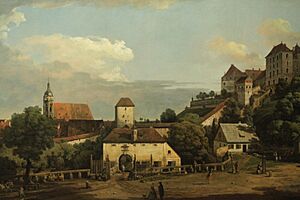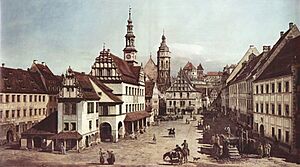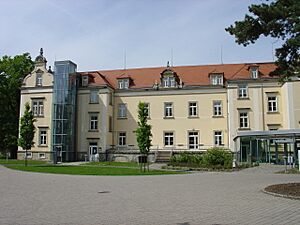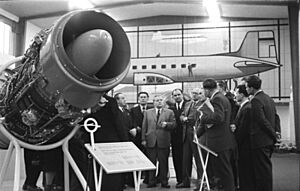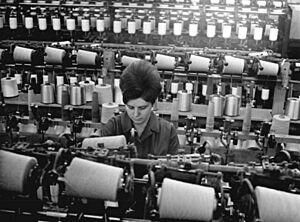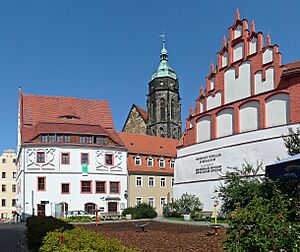Pirna facts for kids
Quick facts for kids
Pirna
|
|||
|---|---|---|---|
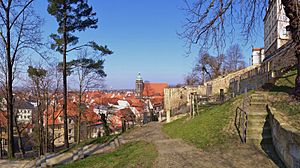
Panorama of the historic centre of Pirna
|
|||
|
|||
|
Location of Pirna within Sächsische Schweiz-Osterzgebirge district
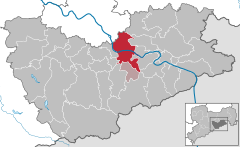 |
|||
| Lua error in Module:Location_map at line 530: Unable to find the specified location map definition: "Module:Location map/data/Germany Sachsen" does not exist. | |||
| Country | Germany | ||
| State | Saxony | ||
| District | Sächsische Schweiz-Osterzgebirge | ||
| Municipal assoc. | Pirna | ||
| Subdivisions | 16 | ||
| Area | |||
| • Total | 53.02 km2 (20.47 sq mi) | ||
| Highest elevation | 340 m (1,120 ft) | ||
| Lowest elevation | 109 m (358 ft) | ||
| Population
(2022-12-31)
|
|||
| • Total | 39,054 | ||
| • Density | 736.59/km2 (1,907.76/sq mi) | ||
| Time zone | UTC+01:00 (CET) | ||
| • Summer (DST) | UTC+02:00 (CEST) | ||
| Postal codes |
01781–01796
|
||
| Dialling codes | 03501 | ||
| Vehicle registration | PIR | ||
| Website | www.pirna.de | ||
Pirna (German: [ˈpɪʁna]) is a town in Saxony, Germany. It is the capital of the Sächsische Schweiz-Osterzgebirge district. Over 37,000 people live in Pirna.
The town is close to Dresden. It is known as an important district town and a Große Kreisstadt, which means it has special administrative duties.
Contents
Exploring Pirna's Location
Where is Pirna Located?
Pirna is found in the upper Elbe valley, near the Elbe Sandstone Mountains. Two rivers, the Wesenitz from the north and the Gottleuba from the south, join the Elbe River here.
People often call Pirna the "gate to Saxon Switzerland" (in German, Tor zur Sächsischen Schweiz). This is because it's a starting point for exploring the beautiful Sandstone Mountains. The Saxon wine region, started in 1992, also begins in Pirna. It stretches through places like Dresden and Meissen.
Towns Near Pirna
Pirna is located southeast of Dresden. It shares borders with several other towns and municipalities. These include Bad Gottleuba-Berggießhübel, Heidenau, and Königstein.
Understanding Pirna's Names
- French: Pirne
- Upper Sorbian: Pěrno
The Language of Pirna
The local way of speaking in Pirna is called Südostmeißenisch. This is a type of Upper Saxon German, which is a group of local dialects.
A Look at Pirna's Past
⎈ Samo’s Empire 631-658
![]() Margraviate of Meissen 1233-1293
Margraviate of Meissen 1233-1293
![]() Kingdom of Bohemia 1293-1405
Kingdom of Bohemia 1293-1405
![]() Electorate of Saxony 1405-1485
Electorate of Saxony 1405-1485
![]() Albertine Duchy of Saxony 1485-1547
Albertine Duchy of Saxony 1485-1547
![]() Electorate of Saxony 1547-1697
Electorate of Saxony 1547-1697
![]() Poland-Saxony 1697-1706
Poland-Saxony 1697-1706
![]() Electorate of Saxony 1706-1709
Electorate of Saxony 1706-1709
![]() Poland-Saxony 1709-1763
Poland-Saxony 1709-1763
![]() Electorate of Saxony 1763-1806
Electorate of Saxony 1763-1806
![]() Kingdom of Saxony 1806-1918
Kingdom of Saxony 1806-1918
![]() German Empire 1871-1918
German Empire 1871-1918
![]() Weimar Republic 1918-1933
Weimar Republic 1918-1933
![]() Nazi Germany 1933-1945
Nazi Germany 1933-1945
![]() Allied-occupied Germany 1945-1949
Allied-occupied Germany 1945-1949
![]() East Germany 1949-1990
East Germany 1949-1990
![]() 1990-present
1990-present
Ancient Times in Pirna
The first signs of people living in this area date back to the late Paleolithic (about 12,000-8000 BC). Tools made of flint from the end of the last ice age show this. Later, during the Neolithic (5500-4000 BC), people from the Linear Pottery culture lived here. They grew crops and raised cattle because the climate was good and the soil was fertile Loess.
Around 600 AD, a Slavic group called the Sorbs settled in the Elbe Valley. They were fishermen and farmers. The name Pirna comes from a Sorbian phrase, na pernem, meaning "on the hard (stone)". It is also linked to the Slavic god Perun.
Pirna in the Middle Ages
After the Germans conquered the Slavic communities, the town of Pirna was founded. A castle in Pirna was first mentioned in 1269, but it likely existed even earlier, in the 11th century. The town was officially recorded in a document in 1233.
In 1293, King Wenceslaus II of Bohemia bought the town and castle. Pirna then belonged to Bohemia until 1405. The streets in the town were laid out in a grid pattern, like a chessboard.
Pirna in Early Modern Times
In 1502, work began on a new church in Pirna. When the Reformation came to Saxony in 1539, Anton Lauterbach, a friend of Martin Luther, became the local pastor.
In 1544, the important castle was made stronger and became a fortress. It survived a siege in 1547 during the Schmalkaldic War. On April 23, 1639, Swedish troops attacked the town. During a long siege of the fortress, the town was badly damaged. About 600 people were killed in what was known as the "Misery of Pirna." Around 1670, the Sonnenstein fortress was built.
Pirna During Prussian and Napoleonic Eras

On August 29, 1756, the Saxon army in Pirna surrendered to the Prussians. This happened after the Prussians invaded without declaring war. In 1758, Austrian troops tried to take the fortress.
In 1774, a factory for printing on cotton fabric (called Kattundruck) opened. In 1811, a large mental hospital was opened in Castle Sonnenstein. However, in 1813, French troops occupied the castle. They forced patients to leave and used the castle for their own needs. Emperor Napoleon even stayed in Pirna for a short time.
Pirna's Industrial Growth
The Industrial revolution brought big changes to Pirna. In 1837, steamship travel started on the Elbe River. A few years later, in 1848, a railway line connected Pirna to Dresden. More railway lines opened later, connecting Pirna to other areas.
Pirna became an industrial town in 1862 with the building of factories. Industries like mechanical engineering, glass, and rayon production grew. In 1875, the sandstone Elbe bridge was finished. During the First World War, Pirna became a military base. By 1922/23, Pirna grew by including several nearby villages, and its population reached about 30,000 people.
Pirna During World War II
From 1940 to 1942, a part of the mental hospital within Sonnenstein Castle was used for terrible purposes. About 15,000 people were killed there. After 1942, the buildings were used as a military hospital.
For a long time, this part of Pirna's history was not widely known. But after 1989, efforts began to remember these events. In June 2000, a permanent exhibition opened. Today, a plaque and the Sonnenstein Memorial help people remember what happened.
Towards the end of World War II, Pirna faced several air raids. These mainly targeted the railway station and tracks. The raid on April 19, 1945, destroyed all railway tracks and the bridge over the Elbe. Many civilians were killed.
Pirna in East Germany (GDR)
During the time of GDR, most people worked in state-owned businesses. These included:
- An artificial silk factory.
- A cellulose fiber factory.
- The VEB Strömungsmaschinen Pirna, which built hydraulic machinery.
- The Wismut mining company in Königstein.
The Pirna 014 turbines for the 152 jet aircraft were built in Pirna. However, most of these businesses closed after Germany was reunified because they could not compete. The Elbe River also became very polluted from industrial waste.
In the mid-1980s, many apartments in Pirna were empty and needed repairs. Some old houses were even torn down. But in 1989, when another old house was planned for demolition, people protested, shouting “Save Pirna!” This led to the creation of the Kuratorium Altstadt (Old Town Board of Trustees), which helped a lot with rebuilding the town after the Berlin Wall fell.
Pirna After German Reunification
After German reunification, many factories in Pirna closed. Over 5,000 jobs were lost in the largest factories. New jobs were created in service industries, but they couldn't make up for all the lost jobs. It was also hard to create new manufacturing jobs because Pirna didn't have a direct connection to a federal highway yet.
Since the 1990s, Pirna's old town has been greatly rebuilt with a lot of funding. More than 90% of the 300 historic buildings have been renovated. The number of people living in the old town has doubled. The market square now has many shops, cafes, and cultural places. During renovations, old features like a 500-year-old wall painting were discovered.
In August 2002, Pirna suffered great damage from widespread flooding. The Elbe River rose very high. The railway line acted like a dam, keeping water in the town longer. Many newly renovated shops were badly damaged when the water pressure broke their windows. Pirna was hit very hard, even more so than Dresden in proportion to its size.
In July 2005, Pirna finally got its own connection to the Bundesautobahn 17, a major highway. This section connected Pirna to Dresden. The highway was extended to the Czech border in December 2006.
In June 2013, Pirna was again affected by severe flooding from the Elbe, though it was not as bad as in 2002. About 7,700 people had to be moved to safety, and around 1,000 buildings were affected by the water.
How Pirna Grew: Village Additions
Over the years, Pirna has grown by adding nearby villages and municipalities. Here are some of them:
- 1850: Hausberggemeinde
- 1922/23: Posta, Niedervogelgesang, Zuschendorf, Neundorf, Rottwerndorf, Hinter-Jessen and Copitz
- 1930: Zehista
- 1950: Cunnersdorf, Mockethal, Zatzschkepp
- 1971: Liebethal
- 1974: Krietzschwitz, Obervogelgesang
- 1998: Birkwitz-Pratzschwitz, Graupa
Pirna's Population Over Time
The number of people living in Pirna has changed over the years:
|
1834 to 1946
|
1950 to 1997
|
1998 to 2003
|
Culture and Arts in Pirna
Museums to Visit
- StadtMuseum Pirna: This is the main museum for the town.
- Botanischen Sammlungen Landschloß Zuschendorf: Here you can see different plant collections.
- DDR Museum Pirna: This museum shows items and memories from the time of East Germany.
- Gedenkstätte Pirna-Sonnenstein: This is a memorial site at Sonnenstein.
- Richard-Wagner-Stätten, Jagdschloss Graupa: A museum dedicated to the famous German composer Richard Wagner.
Music Scene
- Neue Elbland Philharmonie: An orchestra with 60 musicians that performs about 160 concerts each year.
- Pirnaer Jazznacht: A regular event that celebrates jazz music.
Art Events
- Pirna Art Day: An annual day where art is celebrated in the town.
Getting Around Pirna
Pirna station is an important transport hub. It's on the Dresden S-Bahn line and the railway that goes from Dresden to Prague. It's also where a line to Neustadt in Sachsen and Sebnitz begins. Besides the main station, Pirna also has other stations like Obervogelgesang and Pirna-Copitz.
Pirna is also a stop for the Sächsische Dampfschiffahrt ships. These include historic paddle steamers that travel on the Elbe River between Dresden and the Czech border. Local and regional bus services are run by the Regionalverkehr Sächsische Schweiz-Osterzgebirge.
Pirna's Twin Towns
Pirna has "twin town" or "sister city" relationships with several other towns around the world. This means they share cultural and educational exchanges.
Famous People from Pirna
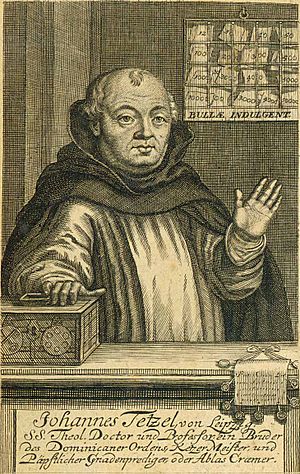
Many notable people have connections to Pirna:
- Johann Tetzel (1465–1519), a Dominican friar.
- Johann Sommer (1542–1574), a theologian and historian.
- Gertrud Eysoldt (1870–1955), an actress and director.
- Siegfried Rädel (1893–1943), a communist town representative.
- Eva Schulze-Knabe (1907–1976), a painter.
- Hermann Rosa (1911–1981), a sculptor and architect.
- Ute Trekel-Burckhardt (born 1939), an opera singer.
- Francesco Friedrich (born 1990), an Olympic champion in bobsledding.
Images for kids
See also
 In Spanish: Pirna para niños
In Spanish: Pirna para niños




